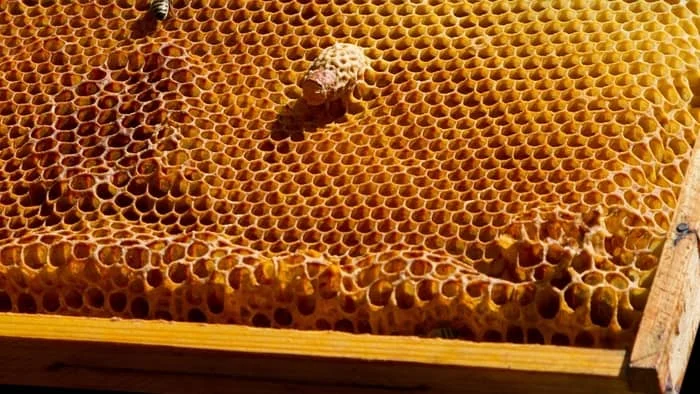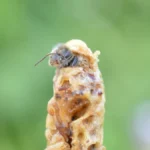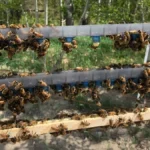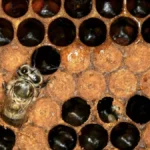In this article, we take a look at the progression in a hive from the queen cup being made to it turning into a queen cell. There are many places in beekeeping where terms can get confusing. We will have a look at how these terms relating to bees rearing new queens work.
A Quick Recap Of How A Queen Bee Is Reared
We have gone into how queen cells work and how queens are reared in a few other articles, but let us just recap here as well.
There are triggers that cause bees to start making queen cells. If there is a drop in the amount of queen pheromone in the hive, the workers start queen rearing.
Common Triggers For Queen Rearing:
1)If the queen in the hive is getting old and failing. Workers will rear a new queen who will probably emerge and lay alongside her mother until she dies. This is called supersedure.
2) The queen can be young and vigorous. This causes the hive to grow in size and the amount of pheromone the queen produces is not enough to control her workers. They start rearing swarm cells. The queen leaves with a reproductive swarm and a new queen hatches and takes over the old hive.
3) If the queen died. You were working the hive and squashed her or she flew away or fell in the grass. Maybe she walked outside at night and got eaten by a toad. She is gone, and a new queen is needed. The bees make emergency queen cells.
What Is A Bee Hive Queen Cup
A queen cup is the start of the queen rearing process. The bees will sometimes make these without eggs being present in them. This is often a sign that the bees are planning to supersede the queen. They can also be a warning sign of impending swarming.
The queen cup is essentially what we call the structure that is where the queen larvae will be reared. Unlike a worker bee cell, these cups are orientated downwards and tend to be at the bottom of a frame or comb. They can however be built in the middle of a frame too.
In many cases, the workers will sometimes keep a few dummy cups like this at the bottom of frames. No eggs will be laid in them, they are just there in case. Some beekeepers remove these to control swarming tendencies.

What Is A Bee Hive Queen Cell?
When an egg is laid in a queen cup, and hatches and begins developing into a queen bee the queen cup begins its transition to a queen cell. As the larva grows, the bees will extend the length of the queen cell until the queen cell is capped. The queen cell now becomes a capped queen cell.
A capped queen cell looks a bit like an unshelled peanut. When a young queen hatches from her queen cell she will run out very quickly and rush around the hive looking for other queen cells. She will then immediately sting into this cell to kill the young queen in there. There can be only one queen they say.
A dead queen in a queen cell will be removed by the bees, and a few days after a young queen emerges you can actually watch the bees remove these. Often if you come to the hive early in the morning you will find the queen cells, dead queens and other debris being moved to the entrance of the hive. Workers will cart these into the sky and drop them somewhere far away from the hive.
Top Ideas On Finding Queen Cups With Eggs Or Larvae
There are times when we open a hive and find the queen and find queen cups with eggs in them. This can suggest that you have a hive that is preparing to swarm, or that you have a failing queen. Hence we need to do a diagnostic test to work out which is the case.
Diagnosing A Failing Queen
Look at the brood nest – a failing queen has a bad laying pattern – a lot of the capped brood will have holes and gaps in it. This is because the queen is just not up to the job anymore and is either laying unfertilized eggs by mistake or just making a mess. These hives will also tend to be a bit weak in comparison to the other hives and seem a bit empty of bees.
You will often find a hive with a failing queen may have significant numbers of drone larvae due to the queen being able to easily lay unfertilized drone eggs, but having some factor that has affected her ability to lay fertilized eggs.
In this case, you can judge the age of the queen cells and just squish the old queen. This eliminates the risk of swarming, and she is making more of a mess of the hive than doing good. The queen cells will hatch and inherit the hive.
You could also requeen the hive. I however am a proponent of allowing locally adapted genes to develop, so breeding your own queens this way is always better in the long run than putting in a queen from afar.
Diagnosing A Hive That Is Developing Swarming Tendencies
If you find a hive that has a lot of bees and a perfect brood nest then you have a hive that has overpopulated itself and is about to swarm. These are the best genes in your area, and killing a queen like this, and requeening is not ideal. Split such a hive – keep the good queen, and remove the queen cells from that hive. Place the frames with queen cells in the split and move this to a new apiary.
If you do this, you are finding the best genes for your area, and you are doubling them by allowing a new queen to emerge who is the daughter of a star queen. In this way, you introduce and enrich good genes.
Fun Things To Do With Extra Queen Cells
If you have to remove queen cells and they are quite mature, it is a really fun task to give them to a little kid. Put the queen cell in a pill bottle and make a few holes in the lid. Small holes. Then tell the child to keep the bottle under its armpit at night and during the day and listen for when the queen hatches.
When the queen hatches, open the lid with the child and help them understand how they provided warmth for the bee to hatch. The look on a child’s face when they become part of this miracle of nature is priceless.
Hopefully, this article has helped you understand queen cups and queen cells more. These cells are truly a miracle of natural engineering and I can never get over how perfect they are. Enjoy and share.
Read more about: How Long Can Bees Stay In A Nuc?
Queen Cup vs Queen Cell FAQs
What is the difference between a queen cup and a queen cell?
A queen cup is an empty, downward-facing cell bees create in preparation for rearing a queen. Once an egg is laid and develops, it becomes a queen cell.
Why do bees create queen cups?
Bees create queen cups to prepare for queen rearing. They may be a sign of supersedure (replacing the old queen) or impending swarming.
Should I remove queen cups if I see them in my hive?
You can remove empty queen cups to manage swarm prevention, but if they contain eggs, it may indicate the hive’s need for a new queen.
What do I do if I find queen cups with eggs or larvae?
Finding queen cups with eggs could indicate a failing queen or swarm preparation. Examine the hive to diagnose and act accordingly.
How can I tell if my queen is failing?
A failing queen usually lays eggs in a scattered pattern, with gaps in brood coverage. Hives with failing queens may also produce more drone larvae.
What are the signs that my hive is preparing to swarm?
A strong, populous hive with a perfect brood nest and multiple queen cups or cells suggests your bees may be preparing to swarm soon.
Can I split my hive if it’s preparing to swarm?
Yes, splitting the hive is a good way to manage swarming while preserving strong genetics. Move queen cells to a new hive to allow the bees to rear a new queen.
What happens when a new queen emerges from her cell?
A newly emerged queen will search for other queen cells in the hive and kill any rival queens inside by stinging them before they hatch.
How do bees remove dead queens from queen cells?
Bees remove dead queens by breaking down the cell and cleaning out the debris, often discarding the remains far from the hive.
Can I use extra queen cells in other hives?
Yes, you can introduce extra queen cells to queenless hives or give them to young beekeepers as an educational experience to witness a queen bee hatching.

Dr. Garth A. Cambray is a Canadian/South African entrepreneur and beekeeper with 28 years of experience in apiculture and specializes in adding value to honey. His Ph.D. research developed a new advanced continuous fermentation method for making mead that has resulted in a number of companies globally being able to access markets for mead. His company, Makana Meadery, exports honey mead to the USA where it is available to discerning connoisseurs. He has also developed technologies to commercially manufacture organic honey vinegar in Zambia for export globally. He holds a few patents globally in the ethanol industry and believes in technology and knowledge transfer for human development and environmental sustainability. One of his proudest achievements is the fact that the wind farm he started at one of his old apiary sites has essentially made his hometown carbon neutral.






